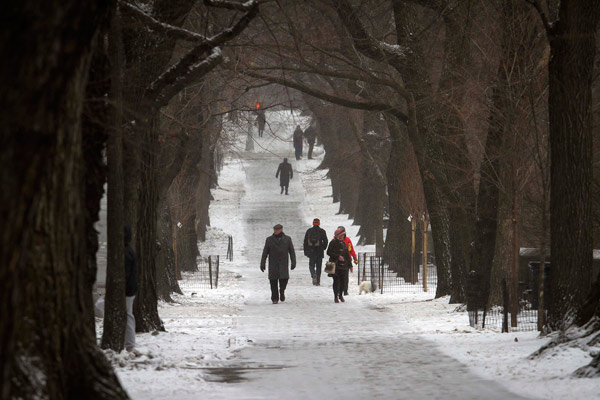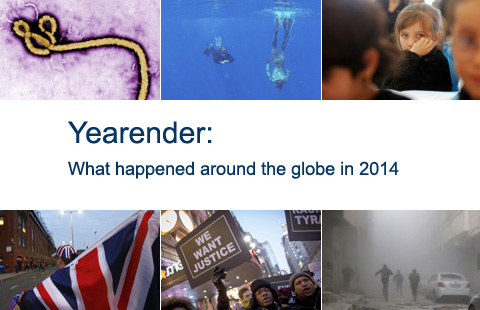Northeastern US braces for 'crippling' blizzard
Updated: 2015-01-27 02:52
(Agencies)
|
|||||||||||
 |
|
People walk up 5th Avenue at Central Park as it snows in the Manhattan borough of New York January 26, 2015. Winter Storm Juno has brought blizzard warning for New York and much of the North East United States. [Carlo Allegri / Reuters] |
NEW YORK - The U.S. Northeast on Monday braced for a massive, crippling blizzard that could dump as much as three feet of snow as tens of millions of people were urged to stay home and airlines canceled thousands of flights.
Transit systems in New York, New Jersey, Connecticut and Massachusetts planned to curtail services, and several governors ordered motorists off roadways by evening in a region that is home to some 50 million people.
The National Weather Service issued a blizzard warning for New York City and surrounding areas between coastal New Jersey and Connecticut, beginning 1 p.m. EST (1800 GMT) on Monday and worsening overnight.
The weather service warned the approaching system would be a "crippling and potentially historic blizzard," with many areas along the East Coast expected to be blanketed by 12 inches to 24 inches (30-60 cm) of snow. The New York City area could be the hardest hit, with lashing winds topping 50 miles per hour (81 kph) and snowfall of three feet or more in some suburbs.
Vacationers and business travelers faced headaches as airlines canceled about 2,700 flights, according to flight-tracking service FlightAware, including nearly 700 flights at the three main airports serving New York City.
STATE OF EMERGENCY
New York Governor Andrew Cuomo declared a state of emergency and deployed National Guard troops to a number of counties in the southern part of the state as well as New York City.
N.Y. authorities said they were considering a total travel ban on main roads, starting at 11 p.m. EST (0400 GMT Tuesday).
"It could be a matter of life and death so caution is required," Cuomo said. "This is not an evening or a night to be out and about."
New York City subways, which carry 5.5 million riders daily, will run on a normal schedule until about 8 p.m., when service will be curtailed to allow subway cars and equipment to be stowed, Cuomo said at a news conference.
New York City public schools, which serve more than 1 million students, will be closed on Tuesday, New York Mayor Bill de Blasio said. Scores of other schools districts were shutting early on Monday.
Two major commuter railroads, Metro-North Railroad and Long Island Rail Road, will run normally until 11 p.m., Cuomo said.
New Jersey Governor Chris Christie declared a state of emergency, and sent all but the most essential government workers home on Monday afternoon, telling them not to return until Wednesday at the earliest. New Jersey Transit commuter trains will stop running for at least one day, beginning at 10 p.m. on Monday, he said.
"Please stay home," Christie told residents.
The governors of Massachusetts and Connecticut told residents to expect driving bans later tonight and all day tomorrow. They warned that hundreds of thousands of people could lose power, possibly for days.
"We are anticipating an historic, top-five storm, based on the snowfall," Massachusetts Governor Charlie Baker told reporters on Monday. The Boston-area transit system will be shut on Tuesday, he said. He warned that coastal parts of the state will likely suffer flooding.
At Boston's Logan International Airport, the last passenger flight was to leave around 7 p.m. EST (midnight GMT) and airlines planned to remove all planes by the day's end.
President Barack Obama, who is traveling in New Delhi, India, was briefed on the coming storm earlier on Monday, White House spokesman Josh Earnest told reporters.
"CLEANED US OUT"
As New York sidewalks turned white, last-minute shoppers grabbed supplies. In a Best Market grocery store in Harlem, about two dozen people stood with filled baskets in a line that stretched the length of the store.
"Usually it's not like that on a weekday morning," store manager Dror Dayce said. "Yesterday they cleaned us out."
Sarah Schaefer, a 31-year old professor at Columbia University, waited to buy canned food and bread. "We've seen instances where they told us to be prepared and it wasn't so bad," she said, "and then other instances it was really bad."
In Brooklyn, lines stretched down the street outside the Park Slope Food Coop, a local favorite. At a nearby grocery, bread and water were almost gone by the morning commute.
The biggest snowfall on record in New York City came during the storm of Feb. 11-12, 2006, dropping 26.9 inches (68 cm), according to the city's Office of Emergency Management.
Cities along the heavily populated East Coast had snow plows and trucks on standby to dispense road salt.
"This will be a long-duration cleanup and I urge everyone to plan accordingly," Connecticut's Gov. Malloy told reporters in Hartford, adding that hundreds of thousands of people could lose power. "If you can leave work early or work from home, please do."
Today's Top News
Greek leftist leader Tsipras claims victory
Favorable visa policy to draw talent
German company counts on brand to lure top people
EU FMs to discuss Ukraine crisis
Expert: What Obama's India visit means to China
China to focus on reforms, opening of capital market
Li Ka-shing set to buy UK's O2
Saudi King Abdullah dies, succeeded by half-brother
Hot Topics
Lunar probe , China growth forecasts, Emission rules get tougher, China seen through 'colored lens', International board,
Editor's Picks

|

|

|

|

|

|





